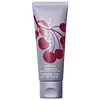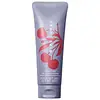What's inside
What's inside
 Key Ingredients
Key Ingredients

 Benefits
Benefits

 Concerns
Concerns

 Ingredients Side-by-side
Ingredients Side-by-side

Water
Skin ConditioningSucrose
HumectantGlycerin
HumectantHydrated Silica
AbrasiveDisodium Laureth Sulfosuccinate
CleansingDehydroxanthan Gum
Emulsion StabilisingSodium Lauroamphoacetate
CleansingPolyacrylate Crosspolymer-6
Emulsion StabilisingMaltodextrin
AbsorbentPolyglyceryl-10 Oleate
Skin ConditioningPropanediol
SolventMalpighia Punicifolia Fruit Extract
AntioxidantVaccinium Macrocarpon Fruit Extract
AstringentLactobacillus/Punica Granatum Fruit Ferment Extract
Skin ConditioningBromelain
Skin ConditioningPapain
Skin ConditioningCaffeine
Skin ConditioningCitric Acid
BufferingTocopherol
AntioxidantOryza Sativa Bran Extract
Skin ConditioningHelianthus Annuus Extract
EmollientRosmarinus Officinalis Leaf Extract
AntimicrobialRaphanus Sativus Root Extract
AstringentLeuconostoc/Radish Root Ferment Filtrate
AntimicrobialSodium Benzotriazolyl Butylphenol Sulfonate
UV AbsorberPentaerythrityl Tetra-Di-T-Butyl Hydroxyhydrocinnamate
AntioxidantCaprylyl Glycol
EmollientPhenoxyethanol
PreservativeChlorphenesin
AntimicrobialBenzoic Acid
MaskingSodium Benzoate
MaskingSodium Metabisulfite
AntioxidantSodium Hydroxide
BufferingParfum
MaskingCI 17200
Cosmetic ColorantCI 16035
Cosmetic ColorantWater, Sucrose, Glycerin, Hydrated Silica, Disodium Laureth Sulfosuccinate, Dehydroxanthan Gum, Sodium Lauroamphoacetate, Polyacrylate Crosspolymer-6, Maltodextrin, Polyglyceryl-10 Oleate, Propanediol, Malpighia Punicifolia Fruit Extract, Vaccinium Macrocarpon Fruit Extract, Lactobacillus/Punica Granatum Fruit Ferment Extract, Bromelain, Papain, Caffeine, Citric Acid, Tocopherol, Oryza Sativa Bran Extract, Helianthus Annuus Extract, Rosmarinus Officinalis Leaf Extract, Raphanus Sativus Root Extract, Leuconostoc/Radish Root Ferment Filtrate, Sodium Benzotriazolyl Butylphenol Sulfonate, Pentaerythrityl Tetra-Di-T-Butyl Hydroxyhydrocinnamate, Caprylyl Glycol, Phenoxyethanol, Chlorphenesin, Benzoic Acid, Sodium Benzoate, Sodium Metabisulfite, Sodium Hydroxide, Parfum, CI 17200, CI 16035
Pyrus Malus Pulp Extract
Skin ConditioningGlycolic Acid
BufferingGlyceryl Stearate Se
EmulsifyingCetearyl Alcohol
EmollientSodium Cocoyl Isethionate
CleansingCaprylic/Capric Triglyceride
MaskingLactic Acid
BufferingPalmitic Acid
EmollientStearic Acid
CleansingCeteareth-20
CleansingButyrospermum Parkii Butter
Skin ConditioningPrunus Avium Seed Oil
EmollientMalpighia Punicifolia Fruit Extract
AntioxidantBromelain
Skin ConditioningPapain
Skin ConditioningLactobacillus/Punica Granatum Fruit Ferment Extract
Skin ConditioningPrunus Cerasus Shell Powder
AbrasiveLitchi Chinensis Seed Powder
AbrasiveFurcellaria Lumbricalis Extract
Skin ConditioningTocopherol
AntioxidantCoconut Acid
CleansingHelianthus Annuus Extract
EmollientRaphanus Sativus Root Extract
AstringentRosmarinus Officinalis Leaf Extract
AntimicrobialOryza Sativa Bran Extract
Skin ConditioningLeuconostoc/Radish Root Ferment Filtrate
AntimicrobialCaprylyl Glycol
EmollientMaltodextrin
AbsorbentPentaerythrityl Tetra-Di-T-Butyl Hydroxyhydrocinnamate
AntioxidantSodium Benzotriazolyl Butylphenol Sulfonate
UV AbsorberSodium Isethionate
CleansingSodium Hydroxide
BufferingPhenoxyethanol
PreservativeParfum
MaskingCI 16035
Cosmetic ColorantCI 19140
Cosmetic ColorantCI 17200
Cosmetic ColorantPyrus Malus Pulp Extract, Glycolic Acid, Glyceryl Stearate Se, Cetearyl Alcohol, Sodium Cocoyl Isethionate, Caprylic/Capric Triglyceride, Lactic Acid, Palmitic Acid, Stearic Acid, Ceteareth-20, Butyrospermum Parkii Butter, Prunus Avium Seed Oil, Malpighia Punicifolia Fruit Extract, Bromelain, Papain, Lactobacillus/Punica Granatum Fruit Ferment Extract, Prunus Cerasus Shell Powder, Litchi Chinensis Seed Powder, Furcellaria Lumbricalis Extract, Tocopherol, Coconut Acid, Helianthus Annuus Extract, Raphanus Sativus Root Extract, Rosmarinus Officinalis Leaf Extract, Oryza Sativa Bran Extract, Leuconostoc/Radish Root Ferment Filtrate, Caprylyl Glycol, Maltodextrin, Pentaerythrityl Tetra-Di-T-Butyl Hydroxyhydrocinnamate, Sodium Benzotriazolyl Butylphenol Sulfonate, Sodium Isethionate, Sodium Hydroxide, Phenoxyethanol, Parfum, CI 16035, CI 19140, CI 17200
 Reviews
Reviews

Ingredients Explained
These ingredients are found in both products.
Ingredients higher up in an ingredient list are typically present in a larger amount.
We don't have a description for Bromelain yet.
Caprylyl Glycol is a humectant and emollient, meaning it attracts and preserves moisture.
It is a common ingredient in many products, especially those designed to hydrate skin. The primary benefits are retaining moisture, skin softening, and promoting a healthy skin barrier.
Though Caprylyl Glycol is an alcohol derived from fatty acids, it is not the kind that can dry out skin.
This ingredient is also used as a preservative to extend the life of products. It has slight antimicrobial properties.
Learn more about Caprylyl GlycolCi 16035 is a synthetic dark-red dye. This dye is created from an acid called Allura red AC, an azo dye.
Azo dyes need to be purified thoroughly before use. This makes them more stable and longer lasting.
This dye is commonly used in foods, approved by both the FDA and EFSA.
Learn more about CI 16035Ci 17200 is a synthetic reddish-purple dye.
Helianthus Annuus Extract comes from the common sunflower.
Sunflowers are rich in vitamin E. Studies show sunflowers contain antimicrobial and antioxidant properties.
The fatty acids found in sunflowers include (from highest amount to least): linoleic acid, myristic acid, palmitic acid, stearic acid, arachidic acid, oleic acid, and linolenic acid.
These fatty acids hydrate your skin. Emollients create a film on the skin to prevent moisture from escaping.
Learn more about Helianthus Annuus ExtractThis ingredient comes from fermenting pomegranate with lactobacillus.
It displays strong antioxidant properties. One study found fermented pomegranate to help with moisture, brightness, elasticity, and collagen after 8 weeks.
Leuconostoc/Radish Root Ferment Filtrate is a natural preservative. It comes from fermenting radish roots with a bacteria called leuconostoc.
Leuconostoc comes from lactic acid.
This ingredient has antimicrobial properties and helps prevent the growth of bacteria in a product.
Leuconostoc is used to make the traditional Korean side-dish, kimchi. It is also used to make sourdough bread (both incredibly yummy foods).
Learn more about Leuconostoc/Radish Root Ferment FiltrateMalpighia Punicifolia Fruit Extract is an antioxidant.
Maltodextrin is a polysaccharide. It is derived from starch such as rice, corn, wheat, or potato starch.
In food, Maltodextrin is used to improve the texture and thicken a product. Due to its structure, it can help create a gel texture. As an emulsion stabilizer, it helps keep the ingredients in a product together.
As a polysaccharide, Maltodextrin has moisturizing properties. Polysaccharides are a type of carbohydrate. The top layer of skin uses polysaccharides to retain water, keeping the skin hydrated.
Maltodextrin is water soluble and has a sweet taste.
Learn more about MaltodextrinOryza Sativa Bran Extract comes from the outer layer of a rice kernel. It is a byproduct of milling rice, or the operation to produce a whole grain rice product.
This ingredient has moisturizing properties due to its components of polysaccharides and omega-3 fatty acids. It also contains calcium, selenium, phosphorus, iron, and zinc.
Oryza Sativa Bran Extract contains numerous antioxidants such as ferulic acid. Antioxidants help fight free-radical molecules. Free-radical molecules are capable of damaging our cells and other genetic material.
Learn more about Oryza Sativa Bran ExtractPapain is an enzyme found naturally in the papaya plant's leaves, fruit, and roots. It has antimicrobial, soothing, and wound healing properties.
Glycine and Vitamin A are naturally found in papain.
While papain is often touted as skin-lightening, further studies are needed to prove this. However, papain has been shown to help soothe acne-inflammation.
Papain belongs to a class of enzymes called proteolytic enzymes. These enzymes break down peptides and amino acids.
Some studies found papain to be a potential skin sensitizer and allergen. Those with latex allergies might also be allergic to papaya.
Learn more about PapainParfum is a catch-all term for an ingredient or more that is used to give a scent to products.
Also called "fragrance", this ingredient can be a blend of hundreds of chemicals or plant oils. This means every product with "fragrance" or "parfum" in the ingredients list is a different mixture.
For instance, Habanolide is a proprietary trade name for a specific aroma chemical. When used as a fragrance ingredient in cosmetics, most aroma chemicals fall under the broad labeling category of “FRAGRANCE” or “PARFUM” according to EU and US regulations.
The term 'parfum' or 'fragrance' is not regulated in many countries. In many cases, it is up to the brand to define this term.
For instance, many brands choose to label themselves as "fragrance-free" because they are not using synthetic fragrances. However, their products may still contain ingredients such as essential oils that are considered a fragrance by INCI standards.
One example is Calendula flower extract. Calendula is an essential oil that still imparts a scent or 'fragrance'.
Depending on the blend, the ingredients in the mixture can cause allergies and sensitivities on the skin. Some ingredients that are known EU allergens include linalool and citronellol.
Parfum can also be used to mask or cover an unpleasant scent.
The bottom line is: not all fragrances/parfum/ingredients are created equally. If you are worried about fragrances, we recommend taking a closer look at an ingredient. And of course, we always recommend speaking with a professional.
Learn more about ParfumPentaerythrityl Tetra-Di-T-Butyl Hydroxyhydrocinnamate (long name, huh?) is a synthetic antioxidant.
It is used to help stabilize other antioxidants or prevent the color from changing in a product.
As an antioxidant, it helps fight free-radical molecules. Free-radical molecules are capable of damaging our cells and other genetic material. Thus, antioxidants may reduce the signs of aging.
This ingredient is oil-soluble.
Learn more about Pentaerythrityl Tetra-Di-T-Butyl HydroxyhydrocinnamatePhenoxyethanol is a preservative that has germicide, antimicrobial, and aromatic properties. Studies show that phenoxyethanol can prevent microbial growth. By itself, it has a scent that is similar to that of a rose.
It's often used in formulations along with Caprylyl Glycol to preserve the shelf life of products.
We don't have a description for Raphanus Sativus Root Extract yet.
Rosmarinus Officinalis Leaf Extract comes from rosemary. Rosemary is native to the Mediterranean.
While Rosmarinus Officinalis Leaf Oil can be volatile due to its fragrant properties, the fragrance components are usually removed in the leaf extract.
Rosemary Leaf Extract contains many antioxidants such as rosmarinic acid and caffeic acid. Rosemarinic acid, a compound found in rosemary leaf, has been found to help soothe skin conditions such as eczema and acne.
Learn more about Rosmarinus Officinalis Leaf ExtractWe don't have a description for Sodium Benzotriazolyl Butylphenol Sulfonate yet.
Sodium Hydroxide is also known as lye or caustic soda. It is used to adjust the pH of products; many ingredients require a specific pH to be effective.
In small amounts, sodium hydroxide is considered safe to use. However, large amounts may cause chemical burns due to its high alkaline.
Your skin has a natural pH and acid mantle. This acid mantle helps prevent harmful bacteria from breaking through. The acid mantle also helps keep your skin hydrated.
"Alkaline" refers to a high pH level. A low pH level would be considered acidic.
Learn more about Sodium HydroxideTocopherol (also known as Vitamin E) is a common antioxidant used to help protect the skin from free-radicals and strengthen the skin barrier. It's also fat soluble - this means our skin is great at absorbing it.
Vitamin E also helps keep your natural skin lipids healthy. Your lipid skin barrier naturally consists of lipids, ceramides, and fatty acids. Vitamin E offers extra protection for your skin’s lipid barrier, keeping your skin healthy and nourished.
Another benefit is a bit of UV protection. Vitamin E helps reduce the damage caused by UVB rays. (It should not replace your sunscreen). Combining it with Vitamin C can decrease sunburned cells and hyperpigmentation after UV exposure.
You might have noticed Vitamin E + C often paired together. This is because it is great at stabilizing Vitamin C. Using the two together helps increase the effectiveness of both ingredients.
There are often claims that Vitamin E can reduce/prevent scarring, but these claims haven't been confirmed by scientific research.
Learn more about Tocopherol